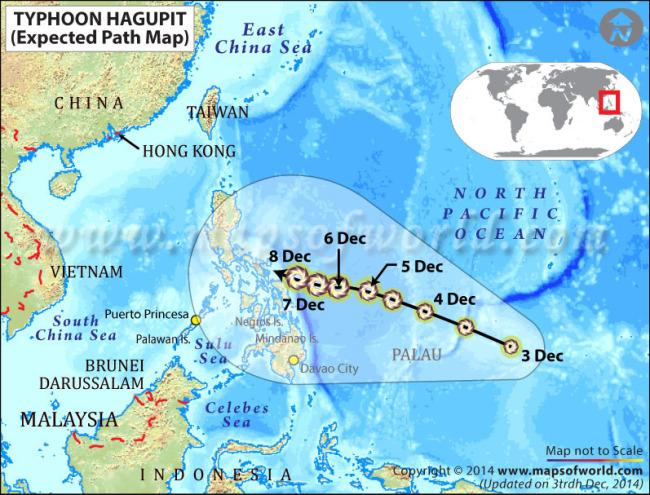
On Dec. 6 a typhoon touched down in the Philippines. Its name is Typhoon Hagupit.
Hagupit, translating to the word “lash,” emerged from the Pacific and moved quickly. The typhoon traveled overseas, cutting off power in the central island of Samar nearby Leyte province, including Tacloban City, considered ground zero of the devastating super typhoon Haiyan last year according to the Huffington Post.
Powerful winds and heavy rain ensued, knocking down trees, houses and power lines in surrounding areas. According to an official of the coastal town of Sulat in Eastern Samar, winds are whirling and waters are already rising.
Typhoon Hagupit is currently a category 3 storm. The severity of a category 3 storm includes significant infrastructure destruction with torrential rain and surges up to 15 feet.
The conditions of Typhoon Hagupit draw parallels to Typhoon Haiyan that hit the Philippines only thirteen months ago.
According to the International Labour Organization, 9.8 million people were affected. Over 650,000 people were displaced and 10,000 estimated dead.
It took months for the Philippines to rebuild their country from the aftermath brought by Haiyan; however, with the help of the EU Humanitarian Aid and Civil Protection and United Nations were able to provide food and aid to survivors that were stranded.
It is vital that these organizations also contribute to provide aid while civilians find shelter as Typhoon Hagupit progresses.
Last year, the undermining of Typhoon Haiyan lead to devastation and shock as 4 million were left homeless or with damaged houses and nearly 10,000 dead in both countries.
While the Philippines has been able to rebuild, over 25,000 still live in tents, shelters or bunkhouses in Samar.
These natural disasters come quickly with little warning. The unforgettable lesson learned by Typhoon Haiyan has led the Filipino government to take extreme precaution and safety before it hits.
Around one million people have fled to shelters and more continue to find shelter as conditions worsen.
Field officers and civilians are aware of the situation within the country, but surrounding countries with powerful allies must be informed as well to protect the lives of defenseless people.
Foreign governments from Southeast Asian countries like Singapore and South Korea released a statement saying they are ready to help.
The United States has recently been informed of the situation and offers to send nine C-130 transport aircraft, three P-3C Orion and medical and relief workers.
International humanities organizations agencies and non-government groups plan to meet to mobilize aid and relief efforts for the aftermath of Typhoon Hagupit.
My heart goes out to the Philippines, a country that has just recovered from a previous natural disaster and must now brace their hearts again for Typhoon Hagupit.
The silver lining from Typhoon Haiyan last November enables the Philippines to prepare and secure the lives of many more civilians. The U.S. and other countries are also preparing efforts to rescue and provide aid after the storm.
The best the Philippines can do right now is take precautionary measures, find safety and protect as many as they can.
For my friends in the Philippines along with the rest of the country, we are all praying for you.














